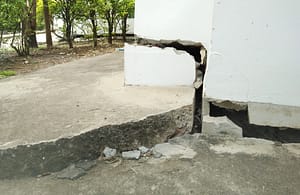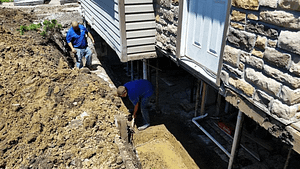The Only Guide to Best Basement Waterproofing
The Only Guide to Best Basement Waterproofing
Blog Article
Top Guidelines Of Best Basement Waterproofing
Table of ContentsFascination About Best Basement Waterproofing6 Easy Facts About Best Basement Waterproofing Described4 Easy Facts About Best Basement Waterproofing ExplainedThe Best Guide To Best Basement WaterproofingBest Basement Waterproofing Fundamentals Explained
uses excavation strategies toward the base of the structure's foundation. involves eliminating wetness after it has gotten in the cellar. AdvantaClean's trained experts and service technicians will find the water resource. If wall surface or piece cracks exist, we will inject polyurethane and epoxies into the splits and seal the concession, protecting against more dampness from getting in.
If there's condensation on the exterior of the aluminum foil, you have high humidity in your cellar. If the foil has condensation on the within surface (next to the wall), the soil around your residence may be normally damp from a high water table or poor dirt drain.
You can waterproof simply your interior walls, which might fix the problem. Or you can waterproof your exterior walls, which is a far better wager but even more pricey. Below's the inside story on the various kinds: These thick finishes are cement-like. Once they dry, they adhere completely to concrete and stonework walls (Best Basement Waterproofing).
What Does Best Basement Waterproofing Mean?
Swirl the brush at the last of application to give the wall surface an appealing, completed look. Concrete waterproof coverings can not be related to formerly repainted surfaces; examine the label. A 5-gallon bucket costs regarding $60. Additionally understood as densifiers, they appropriate only for wall surfaces that haven't been painted or sealed.
You clean, roll, or spray it on much more thickly one gallon covers just 75 square feet, not the 300 square feet common with common paint. Water-proof paint is great for DIY application. You can apply it over painted surfaces, and paint over it once it's cured (one gallon expenses $37).
It can cost $10,000 to $15,000, depending upon the job needed. Outside waterproofing entails digging deep into around the home to the full depth of the structure walls, then installing a water-proof finish or membrane covered by drain panels. The panels supply an easy course for water to move down to an outside French drain at the bottom of your structure.
We've all been captured in a tornado with no umbrella or raincoat (Best Basement Waterproofing). And it's always a dish for calamity: whatever's wet, your hairdo is wrecked, and points are obtaining stuffy. A cellar without waterproofing is sort of like that. Minus the ruined hairstyle component. Your basement doesn't want to undergo browse around this site a rainstorm without proper security equally as long as you don't want to.
Our Best Basement Waterproofing Statements
If you have actually done your study, you would certainly know there are two kinds of look at this now waterproofing: inside and outside. It can get perplexing what they both mean, which one's a better financial investment, and what will in fact keep the water out. Don't worry, we created this blog site to quickly define both approaches for you and go over the pros and disadvantages of each.
Exterior waterproofing is a waterproofing approach that involves sealing your home from the outside. The structure walls are then cleansed, sealed, and covered with a water-proof membrane or sealer.

The Only Guide for Best Basement Waterproofing
It's an extra involved procedure that requires excavating up your yard, which is costly and taxing. Outside waterproofing involves removing everything surrounding the house, including patios, driveways, walkways, landscaping, AC devices, decks, and so forth. If any one of the work was done improperly and water is still entering your cellar, there isn't much you can do to correct or fix it.
Interior cellar waterproofing involves waterproofing from the inside. Any water that leaks into your basement is redirected before it touches your flooring. It's kind of like putting on a raincoat under your clothing. It involves 2 points: a water drain track and a sump pump. It works by securing the within your cellar wall surfaces and more helpful hints floors so water that tries to get in is directed out through a sump pump.
It's a reliable method to water resistant your cellar. The drawback of interior basement waterproofing mostly has to do with the installation procedure.
Excitement About Best Basement Waterproofing
Finally, outside and indoor cellar waterproofing are both efficient approaches of protecting your home from water damages. Outside waterproofing develops a barrier that stops water from entering your home, while indoor waterproofing redirects water that does enter your home. And it's crucial to keep in mind that exterior waterproofing is an expensive and turbulent setup procedure when compared to interior waterproofing.
Whichever approach you pick, make certain you select a reliable and trustworthy specialist for the job. Both techniques need seasoned workers to manage the work. If you have any type of inquiries about cellar waterproofing, please connect to us. And if you remain in our service area and have water in your cellar, call us for a complimentary, no-obligation home inspection.
You can fill out our type right here, start a conversation in the lower right-hand edge, or call us at 1-800-827-0702.
Report this page